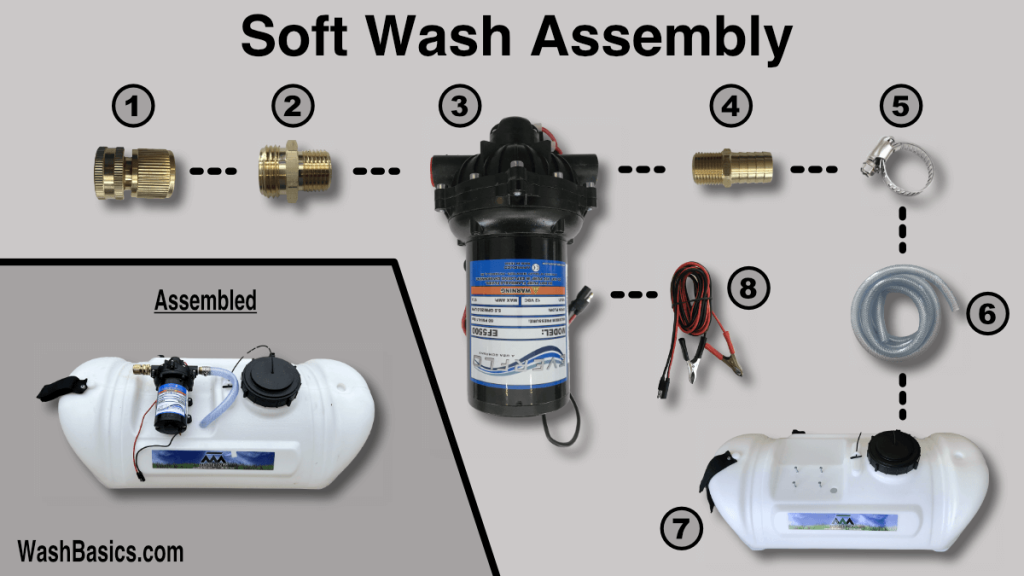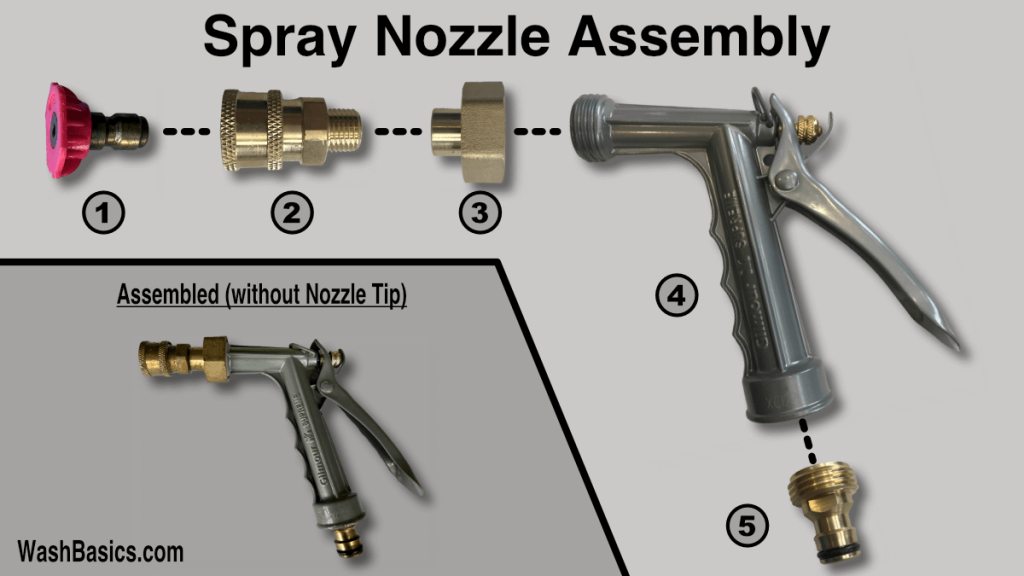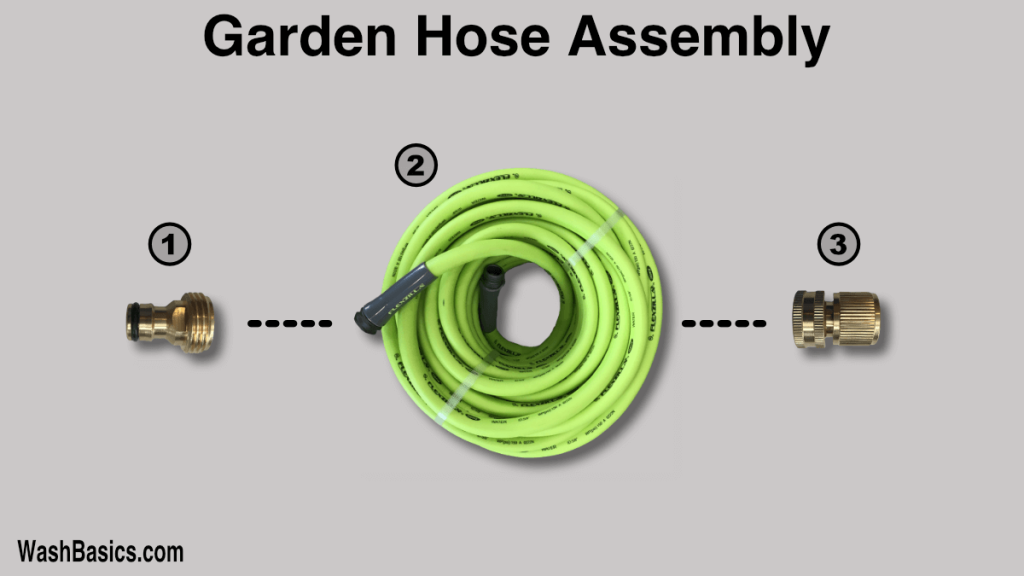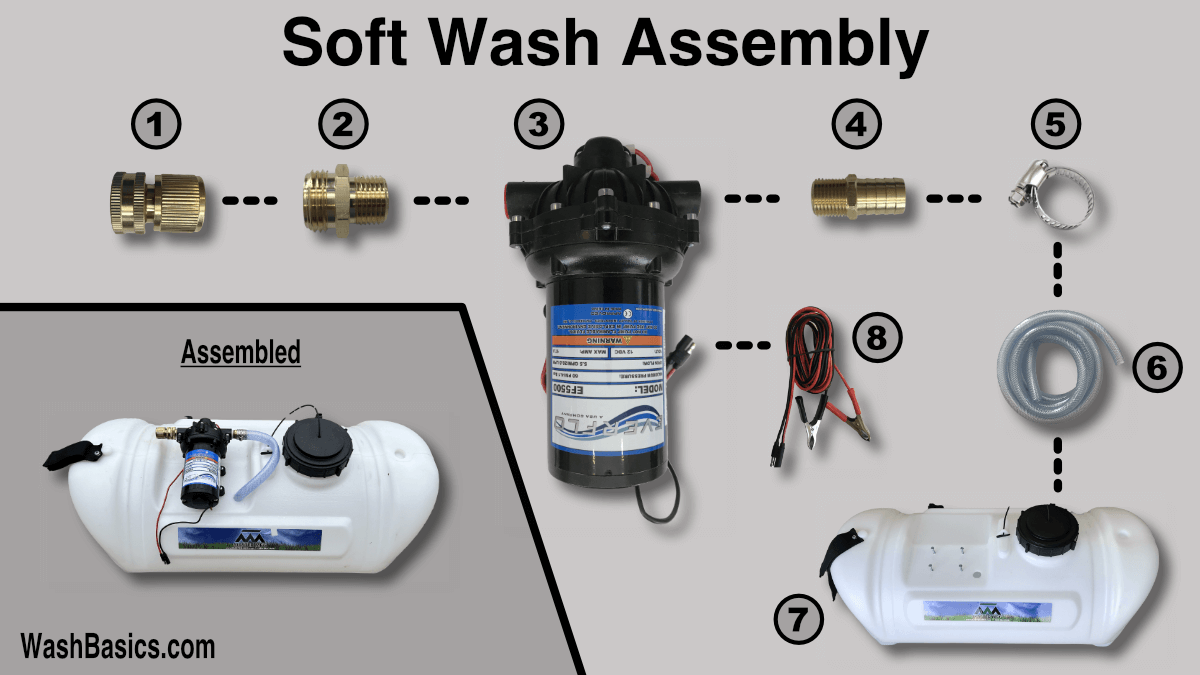Soft washing is a highly effective and efficient method of cleaning various exterior surfaces, including roofs, soffits, and siding. Unlike pressure washing, which can damage surfaces with high-pressure water, soft washing uses a gentle spray mix of water and cleaning solution to safely and thoroughly clean a variety of materials.
A soft wash system is made up of several key components that work together to deliver this cleaning solution to the surface being cleaned. In this article, I’ll show you the components I used to build a low cost system that worked extremely well for me. If you are wanting to build a soft wash system, this article will give you a solid starting point for building your own system. I’ve included the list of parts used and a diagram of how they are generally assembled.
I’ve broken this build into three separate assemblies:
- Soft Wash Assembly – This is the main pump and tank unit.
- Spray Nozzle Assembly – This is the spray nozzle setup. People use many different builds for the spray nozzle. I chose a very simple nozzle assembly that worked extremely well.
- Garden Hose Assembly – This is the hose assembly connecting your soft wash system to your spray nozzle. Choosing a lightweight, flexible hose is key.
We’ll take a look at each assembly starting with the main soft wash assembly. Let’s get into the details:
Soft Wash Assembly

| Item | Description | Quantity |
|---|---|---|
| 1 | 3/4 inch Female Garden Hose Thread (GHT) to GH Quick Disconnect | 1 |
| 2 | 3/4 inch Male GHT to 1/2 inch Male Nation Pipe Thread (NPT) | 1 |
| 3 | 5.5 GPM 12V Diaphragm Pump – 1/2 Female NPT Connections | 1 |
| 4 | 1/2 inch Male NPT to 3/4 inch Inner Diameter (ID) Hose | 1 |
| 5 | 25 mm Hose Clamp | 1 |
| 6 | 3/4 inch ID Flexible Hose | 3 ft |
| 7 | Chemical Tank | 1 |
| 8 | Wire Harness | 1 |
As a starting point for this build, I chose a low-cost 12V chemical spot sprayer. This system came with a 2.2 gallon per minute (GPM) pump, a 25-gallon tank, a hose, and a spray gun. I removed most of everything from the sprayer, only keeping the tank for use in my soft wash system. You may be able to find a cheaper tank solution, but this was the perfect size and price point for my build.
I added a 5.5 GPM 12V diaphragm pump to the tank, along with all of the necessary fittings to complete the assembly. Most of the fittings that I used were brass. As an alternative, you might choose stainless steel fittings for a longer service life, but this will also increase the cost and they can be more difficult to find. I used a garden hose quick disconnect fitting at the end of the pump for fast and easy connection to the hose.
Using a 12V pump requires connection to a battery for power. I connected it to a deep cycle marine battery that I had available. An alternative solution might be to use a 5.5 GPM 120VAC pump instead, which runs on standard household U.S. electrical power.
My final build had no problem spraying the second story of my house and soft washing the roof, producing outstanding results.
Spray Nozzle Assembly

| Item | Description | Quantity |
|---|---|---|
| 1 | Nozzle Tip | 1 |
| 2 | 1/4 inch Quick Disconnect to 1/4 inch Male NPT | 1 |
| 3 | 1/4 inch Female NPT to 3/4 inch Female GHT | 1 |
| 4 | Spray Nozzle | 1 |
| 5 | 3/4 inch GHT Male to GH Quick Disconnect | 1 |
There are many ways to build the spray nozzle assembly. I chose a very simple build using a classic Gilmour spray nozzle.
For the nozzle tips, I simply used low-cost “pink” and “blue” soap nozzle tips. They worked extremely well. As an alternative, you might choose to buy a more expensive “JRod” nozzle tip.
For quick connection to the garden hose assembly, I used a male garden hose quick disconnect fitting at the end of the spray nozzle.
Spray Nozzle Assembly

| Item | Description | Quantity |
|---|---|---|
| 1 | 3/4 inch Female GHT to GH Quick Disconnect | 1 |
| 2 | 5/8 inch Garden Hose | 50 – 100 ft |
| 3 | 3/4 inch Male GHT to GH Quick Disconnect | 1 |
For the garden hose assembly, I chose a super lightweight and flexible 5/8″ garden hose. Then I added quick disconnect fittings to each end.
When you are ready to use the system, simply connect the nozzle to the garden hose. Then connect the garden hose to the soft wash assembly and you are ready to go!
